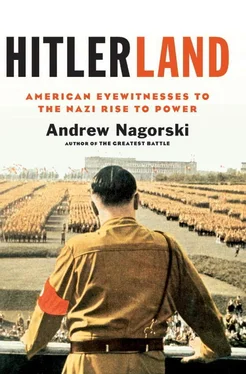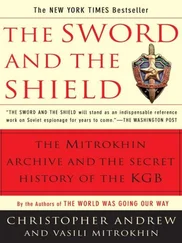Her fascination was in no way diminished by the main subject that Hitler focused on. “The one thing he always raved against was the Jews,” she admitted. He went on about how Jews had prevented him from getting jobs when he was living in Vienna. Helen believed these experiences generated his anti-Semitism. “It began as personal but he built it up politically,” she said.
Who was this American who began hosting Hitler in her home on a regular basis, offering him meals or his favorite duo of black coffee and chocolate—seemingly unconcerned about his dark side? Born in 1893 in New York City, Helen Niemeyer was the daughter of German immigrants, who made sure she spoke German and was aware of her German heritage. But her American identity is on full display in family photos of her dressed as “Liberty”—decked out like the model for the Statue of Liberty and holding a large American flag on the steps of Hoboken’s City Hall. Dated 1912–1913, the photos show her as a young woman of nearly twenty, accompanied by little girls in white dresses and sashes bearing the names of different states.
Soon after they began to see each other socially, Hitler asked Helen: “How do you manage here as an American?” Helen explained about her family roots, noting that she spoke German as fluently as she did English and that she also considered herself “really half and half” in terms of her nationality, despite her U.S. passport.
Putzi told Kay Smith that Helen had walked into his family’s Fifth Avenue shop one day and he had been immediately smitten. “He had been so struck with her beauty he had followed her home,” she recalled. Helen wasn’t film-star beautiful: she was five feet nine inches tall, big-boned, and somewhat matronly looking at an early age. But she had an expressive face with lively blue eyes, kept her hair stylishly back, and wore conservative but chic clothes. Helen and Putzi married on February 11, 1920, their marriage certificate issued by the city clerk in Queens. A year later, after Egon was born, they moved to Munich.
Their marriage wasn’t easy from the beginning. When the Hanfstaengls came to Berlin for a visit and stayed with the Smiths, Kay found Putzi boisterous to the point where she had to keep him in check. At a dinner party the two couples attended, he played the piano magnificently, she noted. “He might have been a concert pianist had he wished to concentrate on that but… he did not work very hard at anything.” When they returned to the Smiths’ apartment on Olivaer Platz, he swung back into action. With a bottle of cognac at his side, he banged out “Harvard, Fair Harvard,” at the same time declaring, “Ah, there’s nothing like Wagner.”
Both Truman and Helen slipped off to their respective bedrooms to go to sleep, but Kay only managed to stop Putzi after four in the morning. Kay recalled that it felt like she had barely fallen asleep when she heard the piano again. Throwing on some clothes, she got him to stop, since Truman and Helen were still sleeping. To keep him from returning to the piano, she convinced Putzi to accompany her on a walk through the nearly empty Tiergarten in the cold early morning hours, telling him that he had to give his wife and her husband some time to rest.
“Ah, the little Helene is always exhausted,” he told her.
“I don’t wonder. You are an exhausting person,” Kay responded. Once Helen finally left Putzi more than a decade later, Kay observed that she had found him “too exhausting.”
But when Helen was new to Germany, she shared many of the same feelings as her husband. She was struck by the economic misery of the postwar period and the political turmoil. “What wonder that in all this chaos a man like A.H. should successfully attract the attention of desperate Germany,” she wrote in her precise handwriting. “His plans for the renaissance of the country sounded ideal for most citizens…”
Among the new American reporters in Germany at that time, there was far from universal agreement that Hitler was a force to be reckoned with. One of the best known was Hubert Renfro Knickerbocker, a red-haired, hard-charging Texan who had already worked in Moscow before moving to Berlin in 1923, although he was only twenty-five when he arrived in the German capital. During the ten years that he was based there, H. R. Knickerbocker, as his byline usually read, published six books in German, wrote regular columns for German newspapers, while still attending to his primary duties initially as a reporter for the International News Service and then for the Philadelphia Public Ledger and the New York Evening Post. As John Gunther, another famous itinerant correspondent and author of that era, recalled, he became “a definite public character in German political life.”
When Knickerbocker first saw Hitler in August 1923, rallying his supporters at the Cirkus Krone in Munich, his reaction was one of comic disbelief. “The first impression he makes on any non-German is that he looks silly… I broke out laughing,” Knickerbocker recalled. “Even if you had never heard of him you would be bound to say, ‘He looks like a caricature of himself.’” He noted not just the mustache and the lock of hair, but also “the expression of his face, and especially the blank stare of his eyes, and the foolish set of his mouth in repose… Other times he clamps his lips together so tightly and juts out his jaw with such determination that again he looks silly, as though he were putting on an act.”
There was something else that also gave Knickerbocker and many of his colleagues pause. “He is softly fat about the hips and this gives his figure a curiously female appearance,” he wrote. “It is possible that the strongly feminine element in Hitler’s character is one of the reasons for his violence.”
By contrast, Putzi Hanfstaengl was in full agreement with his wife about Hitler’s appeal, taking him very seriously. He quickly joined Hitler’s entourage and began regularly playing the piano for him, especially after the Nazi leader’s frequent run-ins with the police, who were increasingly monitoring his activities. The first time Putzi played, he tried out a Bach fugue, but Hitler didn’t show any interest. Then, he launched into the prelude of Richard Wagner’s Meistersinger and he suddenly had Hitler’s full attention. “He knew the thing absolutely by heart and could whistle every note of it in a curious penetrating vibrato, but completely in tune,” Putzi recalled. Hitler started marching up and down, waving his arms as if he were conducting. “This music affected him physically and by the time I had crashed through the finale he was in splendid spirits, all his worries gone, and raring to get to grips with the public prosecutor.”
Hanfstaengl also introduced Hitler to Harvard marching songs, explaining how the music and the cheerleaders were used to whip up the crowds to the point of “hysterical enthusiasm.” He played Sousa marches, and then some of his own improvisations that added the marching beat of American tunes to German ones. “That is it, Hanfstaengl, that is what we need for the movement, marvelous,” Hitler exclaimed, prancing about the room like a drum majorette. Putzi would later write several marches that were used by the Brownshirts, including the one they played when they marched through the Brandenburg Gate on the day Hitler took power in 1933. “Rah, rah, rah! became Sieg Heil, Sieg Heil! but that is the origin of it and I suppose I must take my share of the blame,” Putzi wrote in his autobiography. In fact, this sounded like a case of scarcely concealed pride of authorship.
Putzi contributed to Hitler’s movement in other ways, too. After selling his share of the family art gallery in New York to a partner, he put up $1,000 to turn the four-page Nazi propaganda weekly Völkischer Beobachter into a daily. Hitler complained that regular newspapers ignored him and believed that such a transformation could help overcome that problem. Aside from providing the funding, Putzi hired a cartoonist to design a new masthead. He also claimed credit for thinking up its slogan Arbeit und Brot , work and bread. Although Putzi told Hitler that the $1,000 was a no-interest loan, he would never get it back.
Читать дальше











